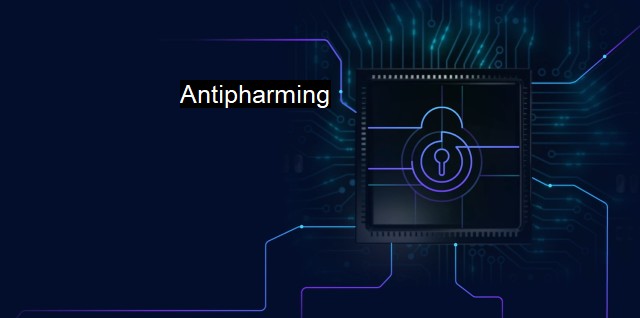What is Antipharming?
The Growing Threat of Antipharming: Sophisticated Tactics and Tools Used in Phishing Attacks to Steal User Credentials and Data
Antipharming is a key concept in the field of cybersecurity and centers on anticipatory techniques used to prevent harmful online activities, particularly the fraudulent directing of web users from legitimate websites to counterfeit ones without their consent or knowledge. A common device used in phishing attacks, pharming operates through the manipulation of IP addressing frameworks to intercept scanning inquiries made by a user's computer with the intentions of deceiving it about the real location of the requested site.In terms of procedural perspectives, the process starts when hackers corrupt the Domain Name System (DNS) server as this holds all mapping details of the respective IP addresses with their corresponding website URLs. This is achieved via DNS cache poisoning or DNS spoofing where the hacker introduces fake or falsified data into a server's DNS cache, changing the IP address linked to the genuine URL resulting in a redirection of user queries.
On the surface, the pharming attack doesn't appear harmful, since it doesn't make changes to the appearance of the illegitimate websites. They are designed so proficiently to look like the authentic pages that users often input their personal, financial or sensitive data without suspecting any untoward activity. This can lead to cybercriminals directly stealing the information or exploiting it to commit further fraudulent activities.
Cybersecurity innovations have spawned the birth of 'antipharming', which employs several methodologies to counter the lateral moves of cyber criminals proficient in pharming. One of the cornerstone antipharming strategies is the employment of secured HTTPS servers. By using HTTPS instead of HTTP, the authenticity of a web server can be confirmed, making it tough for cybercriminals to reroute existing data.
Digital certificates add an extra layer of security insulation against pharming. These are documents containing the server’s public encryption key provided by Certificate Authority (CA), which validates and legitimizes website identity. This unique digital certificate is then used by a server to authorize and confirm its transactions.
Another anticpated method to detect potential pharming efforts is by scanning and reviewing the Uniform Resource Locator (URL). If the URL being redirected doesn't match with the URL contained in trusted bookmarks, the user system could assume a potential pharming scenario.
Antivirus software also plays a crucial role in antipharming. It can not only detect and expel rootkits and Trojans that cybercriminals deploy for creating malicious soccer-or DNS-points but can also block suspicious links, scrutinize encrypted data and inspect network packets to find abnormal changes or behaviour. Regularly updating antivirus software is paramount in maintaining its proficiency in quarantining such cyber threats.
Secure DNS routers are an additional arm of antipharming. As opposed to a traditional DNS, these routers employ encrypted connections to secure websites, lessening the possibility of pharming attacks. Users are guided to check and modify the settings of their router to prevent any unauthorized changes from an external source.
To enhance the resiliency against pharming attacks, it is advisable to constantly update software including the operating system, applications, and computer programs. This is crucial because developers often issue updates that not only bring improvements but also resolve potential security holes that cybercriminals could exploit.
As digital transactions and online interactions grow exponentially, safeguarding data from innovative hacking strategies like pharming becomes overwhelmingly critical. Antipharming is a powerful tool against this threat, it is optimized through a combination of awareness, sophisticated antivirus software, secure servers and systems, strong cryptography, and robust cybersecurity practices. The future of cybersecurity lies not only in more advanced technologies but also lies in educating the average user, making them cognizant about the possibility of deceptions and designing protocols for quick resolution if an eventuality occurs.

Antipharming FAQs
What is antipharming?
Antipharming is a cybersecurity measure that prevents attackers from redirecting internet traffic from legitimate websites to a fake website that appears identical to the original site.How does antipharming protect against cyber threats?
Antipharming employs various techniques to detect and prevent unauthorized access to a legitimate website. It can identify and block malicious traffic, restrict access to unauthorized users, and use multi-factor authentication to prevent unauthorized access.Is antipharming the same as antivirus?
No, antipharming is not the same as antivirus. Antipharming focuses on preventing attackers from redirecting traffic while antivirus software detects and removes malware from a system.Who needs antipharming protection?
Businesses, organizations, and anyone who owns a website that requires user login information should consider implementing antipharming protection. It is an essential cybersecurity measure to prevent phishing, identity theft, and other cyber attacks.| | A | | | B | | | C | | | D | | | E | | | F | | | G | | | H | | | I | | | J | | | K | | | L | | | M | |
| | N | | | O | | | P | | | Q | | | R | | | S | | | T | | | U | | | V | | | W | | | X | | | Y | | | Z | |
| | 1 | | | 2 | | | 3 | | | 4 | | | 7 | | | 8 | | |||||||